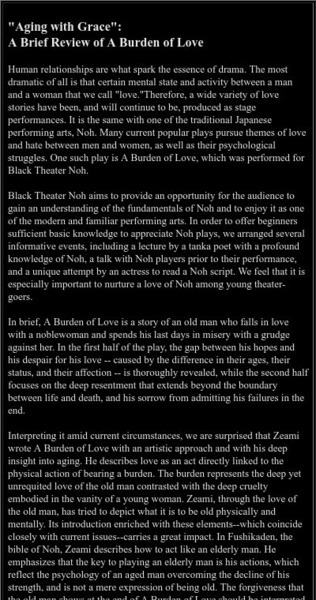Khan Academy
Khan Academy: Japanese Art: The Formats of Two Dimensional Works
Japanese two-dimensional works of art can take several different formats. Read about handscrolls and hanging scrolls and view examples in this essay.
Khan Academy
Khan Academy: Hokusai, Under the Wave Off Kanagawa (The Great Wave)
Katsushika Hokusai's "Under the Wave off Kanagawa", also called "The Great Wave" has become one of the most famous works of art in the world-and debatably the most iconic work of Japanese art. View the picture and read the history behind...
Metropolitan Museum of Art
Metropolitan Museum of Art: Look for the Symbol in the Sculpture
This websites answers the question, "What is a Symbol?" Click on the sculptures for a description of the symbols in each work.
Khan Academy
Khan Academy: An Introduction to the Samurai
This article describes the rise and fall of the Shogunate in Japan. Included are pictures of Japanese art from these periods in Japanese history.
Khan Academy
Khan Academy: Cassatt, the Coiffure
Mary Cassatt's motivation in making her prints was to make her art more accessible for a large audience. She believed that everyone, regardless of income or social position, should be able to experience art and to own works they enjoy....
Khan Academy
Khan Academy: Buddhism in Japan
Buddhism would revolutionize many aspects of Japanese life including music, dance, a new writing system, and above all, elaborate Buddhist art. View a picture of a Buddhist sculpture and read a brief history of Buddhism in Japan.
Other
Aichi Arts Center: Aging With Grace: A Brief Review of "A Burden of Love"
This site provides a review and summary of Zeami's noh drama, "A Burden of Love." The author includes details about how the noh performer would portray a part.
Khan Academy
Khan Academy: Fresh Water Jar
This is a container to hold cold, fresh water made especially for use in the Japanese tea gathering. Its shape reminds us of a wooden bucket used to carry water from a well, but it is made out of porcelain, a glazed ceramic fired at a...
Khan Academy
Khan Academy: Tea Bowl With Dragon Roundels
This bowl was used for the tea ceremony. Learn when and how the Japanese people began to drink tea, what the dragon symbolizes, and who the artist is.
Khan Academy
Khan Academy: Archery Practice
This painting depicts one of several forms of archery practice formalized as early as the Kamakura period (1185-1333), this activity trained warriors to shoot accurately at moving targets while riding at a full gallop. View this picture...
Khan Academy
Khan Academy: Todai Ji
When completed in the 740s, Todai-ji (or "Great Eastern Temple") was the largest building project ever on Japanese soil. Its creation reflects the complex intermingling of Buddhism and politics in early Japan. View pictures and read...
Khan Academy
Khan Academy: Short Sword (Wakizashi) and Long Sword (Katana)
Sword making is a highly refined and respected art in Japan, part of a ritualized process requiring decades of training. View two examples and read the background of the importance of swords to the Japanese people.
Khan Academy
Khan Academy: Tea Bowl With Standing Crane Design (Gohon Tachizuru)
View a picture of a Japanese tea bowl and read about how it was used in tea gatherings during the Muromachi period.
Khan Academy
Khan Academy: Fresh Water Jar
This vessel is a container to hold cold, freshwater made especially for use in the Japanese tea gathering during the Muromachi period. View a picture of this jar and read about the details in this essay.
Khan Academy
Khan Academy: Scenes From the Tale of Genji
This pair of screens illustrates scenes from four chapters of Japan's classic literary work, "The Tale of Genji," written by a female courtier by the name of Murasaki Shikibu in around the tenth-eleventh centuries. It is a romantic novel...
Khan Academy
Khan Academy: Arrival of a Portuguese Ship
In 1543, three Portuguese travelers aboard a Chinese ship drifted ashore on Tanegashima, a small island near Kyushu. They were the first Europeans to visit Japan. In 1548, Francis Xavier, a Jesuit, arrived from Goa to introduce...
Other
Joseph Wu Origami: What Is Origami?
A brief history of the art of Origami by Joseph Wu. Basic techniques, types of paper, and terminology are discussed.
Khan Academy
Khan Academy: Introduction to Japan
Read a short essay on Japan's geography and how it affected the culture of Japan.
Khan Academy
Khan Academy: Female Shinto Spirit
This figure represents a Shinto goddess; her name is not known. She is depicted as an aristocratic woman, dressed in a thick kimono-like garment. Shinto images like this one were not meant to be seen but were kept hidden in movable...
Khan Academy
Khan Academy: The Floating World of Edo Japan
During Japan's Edo period (1615-1868) the phrase "the floating world" (ukiyo) evoked an imagined universe of wit, stylishness, and extravagance -- with overtones of naughtiness, hedonism, and transgression. Implicit was a contrast to the...
Khan Academy
Khan Academy: Matchlock Gun and Pistol
Owning a pistol was a symbol of a samurai's power, rank, and wealth in Edo, Japan. They were often decorated with the samurai's family crest. View pictures and read descriptions of these weapons.
Khan Academy
Khan Academy: Dog Chasing
Dog chasing was one of three archery drills popular during the Edo period (1615-1868). Originally an exercise to improve martial skills, it became a formal sport with defined rules as early as the 14th century.
Khan Academy
Khan Academy: The Evolution of Ukiyo E and Woodblock Prints
Ukiyo-e began as hand-painted scrolls and screens of everyday life in Japan. They became so popular, they were mass-produced using carved wooden blocks. Read the evolution of this artform and view pictures in this essay.
Other popular searches
- Japanese Art and Music
- Japanese Art Criticism
- Japanese Art Activities
- Japanese Art for Children
- Heritage Japanese Art
- Japanese Art Project
- Japanese Art Lessons
- Japanese Art Paintings
- Hiroshtige Japanese Art
- Japanese Internment Articles
- Japanese Art Lesson Plans
- Art Japanese Calligraphy























